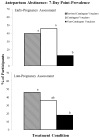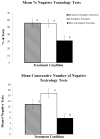Examining two different schedules of financial incentives for smoking cessation among pregnant women
- PMID: 24704135
- PMCID: PMC4183736
- DOI: 10.1016/j.ypmed.2014.03.024
Examining two different schedules of financial incentives for smoking cessation among pregnant women
Abstract
Objective: To examine whether an efficacious voucher-based incentives intervention for decreasing smoking during pregnancy and increasing fetal growth could be improved without increasing costs. The strategy was to redistribute the usual incentives so that higher values were available early in the quit attempt.
Method: 118 pregnant smokers in greater Burlington, Vermont (studied December, 2006-June, 2012) were randomly assigned to the revised contingent voucher (RCV) or usual contingent voucher (CV) schedule of abstinence-contingent vouchers, or to a non-contingent voucher (NCV) control condition wherein vouchers were provided independent of smoking status. Smoking status was biochemically verified; serial sonographic estimates of fetal growth were obtained at gestational weeks 30-34.
Results: RCV and CV conditions increased point-prevalence abstinence above NCV levels at early (RCV: 40%, CV: 46%, NCV: 13%, p=.007) and late-pregnancy (RCV: 45%; CV: 36%; NCV, 18%; p=.04) assessments, but abstinence levels did not differ between the RCV and CV conditions. The RCV intervention did not increase fetal growth above control levels while the CV condition did so (p<.05).
Conclusion: This trial further supports the efficacy of CV for increasing antepartum abstinence and fetal growth, but other strategies (e.g., increasing overall incentive values) will be necessary to improve outcomes further.
Trial registration: ClinicalTrials.gov NCT01801384.
Keywords: Birth outcomes; Contingency management; Fetal growth; Financial incentives; Pregnancy; Smoking cessation; Tobacco; Vouchers.
Copyright © 2014 Elsevier Inc. All rights reserved.
Conflict of interest statement
Figures



References
-
- American College of Obstetricians and Gynecologists (ACOG) Need help putting out that cigarette? Washington, DC: ACOG; 2001. Retrieved October 2, 2013, from http://tobaccocessation.org/sf/pdfs/cpr/16%29%20NeedHelp%20Booklet.pdf.
-
- Bernstein IM, Goran MI, Amini SB, Catalano PM. Differential growth of fetal tissues during the second half of pregnancy. Am J Obstet Gynecol. 1997;176(1):28–32. - PubMed
-
- Centers for Disease Control and Prevention. Vital signs: Current cigarette smoking among adults aged ≥18 years–United States, 2009. Morbidity and Mortality Weekly Report. 2010;59:1135–1140. Retrieved October 2, 2013, from http://www.cdc.gov/mmwr/preview/mmwrhtml/mm5935a3.htm?s_cid=mm5935a3_w. - PubMed
-
- Cnattingius S. The epidemiology of smoking during pregnancy: Smoking prevalence, maternal characteristics, and pregnancy outcomes. Nicotine Tob Res. 2004;6(Suppl 2):S125–S140. - PubMed
-
- Cohen G, Jeffery H, Lagercrantz H, Katz-Salamon M. Long-term reprogramming of cardiovascular function in infants of active smokers. Hypertension. 2010;55:722–728. - PubMed
Publication types
MeSH terms
Associated data
Grants and funding
LinkOut - more resources
Full Text Sources
Other Literature Sources
Medical

